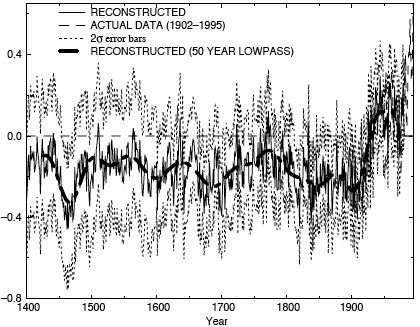Reading/Discussion Assignment:
Read the following articles, (linked directly from Canvas):
1. Plutzer, E., M. McCaffrey, A. L. Hannah, J. Rosenau, M. Berbeco, A. H. Reid, (2016) Climate Confusion Among U.S. Teachers. Science 351, 664-665.
2. Schiermeier, Q. (2010) The Real Holes in Climate Science. Nature 463, 284-287.
3. Kahan, D. (2010) Fixing the communications failure. Nature 463, 296-297.
And skim these two articles, (also linked directly from CANVAS):
4. Hegerl, G. (1998) Climate Change: Past as guide to the future. Nature 392, 758-759.
5. Mann, M. E., R. S. Bradley, and M. K. Hughes (1998) Global scale temperature patterns and climate forcing over the past six centuries. Nature 392, 779-787.
Teaching and Learning! (and Eliza's soapbox)
Climate scientists for many years hoped that the preponderance of observational data from a variety of sources would "speak for itself" and convince even the most jaded skeptics that the Earth is indeed warming. To their great dismay, the politics of global climate science continues to be as contentious as ever. As educators, it is up to us to train the world's future decision-makers. We need to make sure the general population has the ability to make logical conclusions based on observations, to evaluate a scientific argument, and to appreciate the social and psychological implications of the intersection of science and policy. I picked the articles above to get us thinking about these topics. A short preview of them:
Dan Kahan's article is an excellent piece on scientific communication and it explains how people align themselves with certain viewpoints. Quirin Schiermeier's piece is a straightforward treatment of what we don't know about Earth's climate. He makes an important point that every minute scientists waste debating facts that nobody should dispute is a minute not spent searching for the answers to the pressing knowledge gaps he writes about.

The other two articles are science research articles. The 1998 paper by Mike Mann and coauthors is the one that has the original "hockey stick" graph (reproduced above) that shows the recent abrupt upward swing in global temperatures based on a variety of observed and proxy data. The piece by Gabriele Hegerl is a "News and Views" article, similar to other ones you've read before in this class. The point of a "News and Views" article in Nature is to summarize a research paper in the same issue, putting it into context so that other scientists outside the field may appreciate the original article's impact. I put Mike Mann's article in our course reserves precisely because I think it is important for you to be exposed to the actual science at the heart of the controversy, as opposed to only hearing the spin on either side of the debate. Let me point out that I am only asking you to skim this article because it is extremely complicated and lengthy. It was not written for a general audience of nonscientists! In fact, you'd have to be pretty far inside the loop to make a considered judgment of their statistical analysis and evaluate all the different datasets that went into this paper. I still think you should have a look at it, though.
Consider these questions for our discussion:
- Consider the paper by Kastens et al. that we read way back in Lesson 1. How do feedback loops, spatial awareness, and deep time figure in to the debate about climate?
- Consider the paper by Bloom and Weisberg that we read way back in Lesson 1 about how people process scientific concepts they are unfamiliar with. How do the tendencies discussed in that paper impact the climate debate? Do the concepts Bloom and Weisberg talk about seem validated by the Plutzer et al. paper?
- What role should scientists play in communication with the public? What role should journalists play? What role should educators play? What role should politicians play?
- What is the appropriate level of education secondary students should receive about global climate and how do you navigate the politics of this subject?
Participating in the Teaching/Learning/Reading Discussion
- Enter the "Teaching and Learning About Climate Change" discussion forum in Canvas
- You'll see the reading guidance questions there, but I also want you to contribute your own thoughts about how this issue is or is not addressed in your community.
- Read postings by other EARTH 501 students, too, and respond to at least one other posting by asking for clarification, asking a follow-up question, expanding on what has already been said, etc.
Grading criteria
You will be graded on the quality of your participation. Please see the rubric for teaching/learning discussions.